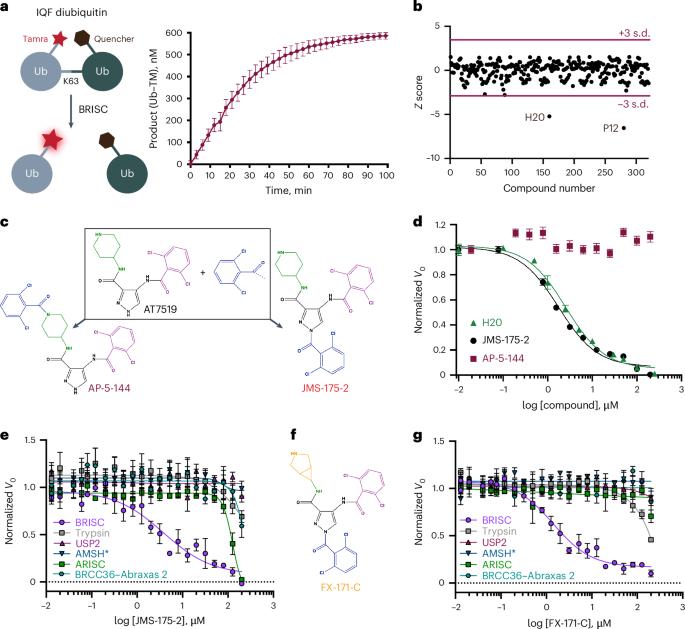抑制去泛素化酶活性和炎症信号传导的分子粘合剂
IF 10.1
1区 生物学
Q1 BIOCHEMISTRY & MOLECULAR BIOLOGY
引用次数: 0
摘要
去泛素化酶(DUB)在细胞信号传导过程中起着至关重要的作用,而且经常受到蛋白质复合物内部相互作用的调控。BRCC36 异肽酶复合物(BRISC)通过裂解 I 型干扰素受体(IFNAR1)上 K63 链接的多泛素链来调节炎症信号转导。作为一种 Zn2+ 依赖性 JAMM/MPN(JAB1、MOV34、MPR1、Pad1 N-terminal)DUB,BRCC36 难以成为选择性抑制剂的靶标。在这里,我们发现了第一类抑制剂,称为 BRISC 分子胶(BLUEs),它能将 16 个亚基的人类 BRISC 二聚体稳定在自抑制构象中,阻断活性位点以及与靶向亚基丝氨酸羟甲基转移酶 2 的相互作用。与具有相同催化亚基的相关复合物、剪接变体和其他 JAMM/MPN DUBs 相比,这种独特的作用模式可选择性地抑制 BRISC。在含有野生型 BRISC 的细胞中,BLUE 会降低干扰素刺激的基因表达,而在使用结构引导的、抗抑制剂的 BRISC 突变体时,这种效应就会消失。此外,BLUEs 还能增加 IFNAR1 泛素化,降低 IFNAR1 表面水平,为缓解 I 型干扰素介导的疾病提供了一种潜在的策略。我们的方法还为设计大型蛋白质复合物的选择性抑制剂提供了一个模板,即促进而不是阻断蛋白质与蛋白质之间的相互作用。本文章由计算机程序翻译,如有差异,请以英文原文为准。


Molecular glues that inhibit deubiquitylase activity and inflammatory signaling
Deubiquitylases (DUBs) are crucial in cell signaling and are often regulated by interactions within protein complexes. The BRCC36 isopeptidase complex (BRISC) regulates inflammatory signaling by cleaving K63-linked polyubiquitin chains on type I interferon receptors (IFNAR1). As a Zn2+-dependent JAMM/MPN (JAB1, MOV34, MPR1, Pad1 N-terminal) DUB, BRCC36 is challenging to target with selective inhibitors. Here, we discover first-in-class inhibitors, termed BRISC molecular glues (BLUEs), which stabilize a 16-subunit human BRISC dimer in an autoinhibited conformation, blocking active sites and interactions with the targeting subunit, serine hydroxymethyltransferase 2. This unique mode of action results in selective inhibition of BRISC over related complexes with the same catalytic subunit, splice variants and other JAMM/MPN DUBs. BLUE treatment reduced interferon-stimulated gene expression in cells containing wild-type BRISC and this effect was abolished when using structure-guided, inhibitor-resistant BRISC mutants. Additionally, BLUEs increase IFNAR1 ubiquitylation and decrease IFNAR1 surface levels, offering a potential strategy to mitigate type I interferon-mediated diseases. Our approach also provides a template for designing selective inhibitors of large protein complexes by promoting rather than blocking protein–protein interactions. The BRCC36 isopeptidase complex (BRISC) is a deubiquitylase that stabilizes interferon receptors, driving inflammation. We discovered ‘BRISC molecular glue’ inhibitors (BLUEs) that selectively inactivate BRISC, promoting interferon receptor ubiquitylation and degradation to dampen immune responses.
求助全文
通过发布文献求助,成功后即可免费获取论文全文。
去求助
来源期刊

Nature Structural & Molecular Biology
BIOCHEMISTRY & MOLECULAR BIOLOGY-BIOPHYSICS
CiteScore
22.00
自引率
1.80%
发文量
160
审稿时长
3-8 weeks
期刊介绍:
Nature Structural & Molecular Biology is a comprehensive platform that combines structural and molecular research. Our journal focuses on exploring the functional and mechanistic aspects of biological processes, emphasizing how molecular components collaborate to achieve a particular function. While structural data can shed light on these insights, our publication does not require them as a prerequisite.
 求助内容:
求助内容: 应助结果提醒方式:
应助结果提醒方式:


